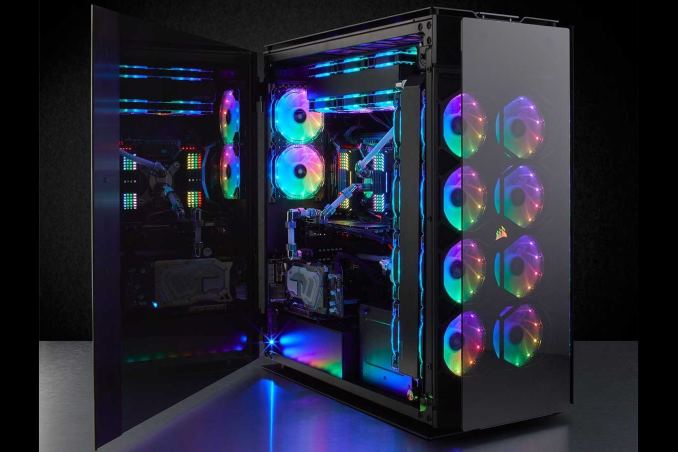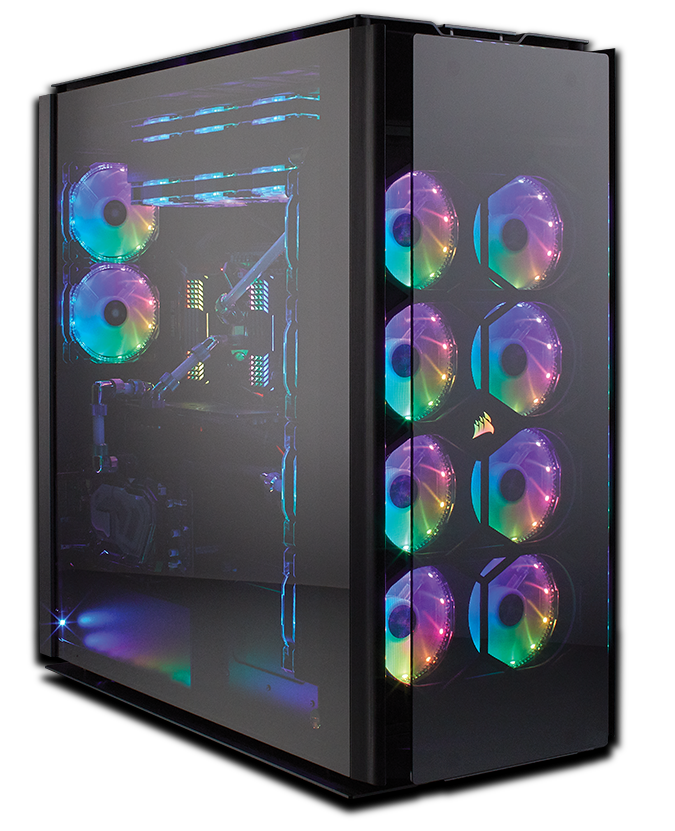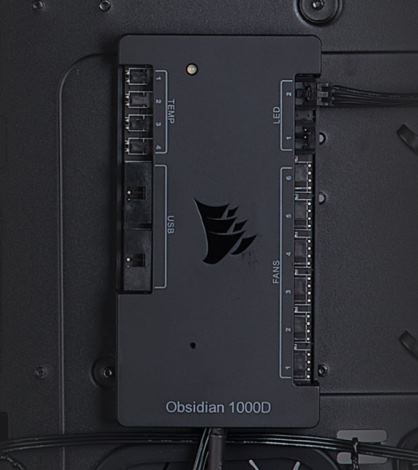When Size Matters: Corsair Launches Obsidian 1000D Super-Tower Case
by Joe Shields on May 15, 2018 1:30 PM EST
A few days ago, Corsair announced the launch of its most ambitious and largest case yet with the new Obsidian 1000D Super-Tower PC Case. Just as its name implies the case is quite large. So large in fact, it is able to house a complete E-ATX and Mini-ITX system concurrently - two motherboards, two power supplies, two full PCs in one case. It's not all about what can fit on the inside however that makes the case. The exterior styling uses brushed aluminum and includes four smoke tempered glass panels which help give the Super-Tower a premium appearance that can be a focal point of an enthusiast build. The inside is designed to house some of the most ambitious and powerful PCs imaginable inside its dual-system, three-chambered layout.
The chassis measures in at a real estate-heavy 27.3” x 12.1” x 27.3” (LxWxH) which easily eclipses the 900D from years ago. The entire case, empty, weighs in at a hefty 65lbs making this thing a bit cumbersome to move around I'd image. The exterior of the case is adorned by the smoke tinted tempered glass panels. Where there isn’t glass, on top (the two flanking panels), there are brushed aluminum details adding to the overall high-end vibe it exudes.
The louvered top is raised from the chassis allowing for air to exhaust, though perhaps not free-flowing. There is ample room in front for intake through its large dust filter (dust filters are also found on the rear, top, and bottom) so airflow shouldn’t be an issue. The chassis supports eight fans up front (13 in total) to get cool air in the chassis. The back panel has a total of seven expansion slots for PCIe, nine including the vertical GPU mounting space (video card can be mounted either way). Towards the bottom is space for the two power supplies as well as a Mini-ITX sized motherboard. Both glass side panels use hinges at the back and open up for easier access.
Sparing little expense, the front panel is loaded with modern options including two USB 3.1 Type-C ports (a rarity to have one today), and four USB 3.0 ports for a lot of USB storage options. Other buttons/ports include the power and reset buttons and 3.5 mm jacks for headphone and microphone. Unique to the 1000D, the power button and all USB ports have RGB LED backlighting in them lighting up that portion of the case I don’t recall seeing that in a chassis before. Using the integrated Corsair Commander Pro fan and lighting controller (mounted on the motherboard tray), users are able to control up to six PWM fans and two RGB LED strips through the iCUE software. The controller also has four temperature probes and contains the plugs for the front panel USB 3.0 ports.
Inside the case, the primary E-ATX system mounts to a raised motherboard ‘island’ with cable routing holes throughout. The motherboard island is backed by French-door-type rear compartment that holds the 2.5” drives and hides cables. The Mini-ITX system sits above the ATX PSU mount. AS far as storage goes, the 1000D will hold a whopping 11 drives; five in 3.5-inch format and six 2.5-inch each in their own dedicated compartments. That should be plenty of internal storage, even with two systems inside.
Using two different systems in one case can pose some cooling challenges. To combat this potential issue, the 1000D has many cooling options. The front panel holds up to eight 120mm fans, three 140mm fans on top and two 120/140mm fans mounts on the back for a total of 13 fans - none of which appear to be included. Corsair says there is room for up to four 480mm radiators simultaneously (requires the purchase of additional trays). By default, it will hold 2x480mm radiators in front, and one 420mm radiator on top. Fan and radiator installation should be a bit easier as the chassis has built-in radiator mounting trays which slid out from the chassis. Corsair says there is a wide variety of pump and reservoir mounting points adding to its flexible nature inside.
The Corsair 1000D is truly a beast of a case allowing for TWO systems to fit inside, plenty of storage for BOTH systems, as well as integrated fan and RGB controller. While beauty is in the eye of the beholder, the tempered glass panels and brushed aluminum details do give the case a premium look. With its premium look does come a premium price. The 1000D is available now at your favorite etailers including Amazon and Newegg. Pricing comes in at a wallet-emptying $499.99 which puts it in the company of fully customized cases. The case includes a two-year warranty as well.
| Corsair Carbide 1000D Super-Tower | ||
| Model | 1000D | |
| Case Type | Super-Tower | |
| Dimensions | (W)12.1" (H) 27.4" (D)27.3" |
|
| Color | Black | |
| Material | Aluminum / Tempered Glass | |
| Net Weight | 29.4kg | |
| External Drive Bays | None | |
| HDD/SSD Bays | 11 (5 x 3.5" + 6 x 2.5") | |
| Expansion Slots | 7 (+2 for vertical GPU) | |
| Motherboard Type | Up to E-ATX (Primary) Mini-ITX (Secondary) |
|
| System Fan | Front: 8x 120mm Top: 3x 140mm Rear: 2x 120/140mm |
|
| I/O Ports | 2x USB 3.1 Type-C 4x USB3.0 2x 3.5mm jacks Power and Reset Buttons |
|
| VGA Card Support | (L)400mm | |
| CPU Cooling Support | (H)180mm | |
| PSU Support | ATX PSU (Primary) SFX (Secondary) |
|
| Radiator Support | Front: 2x 480mm Top: 1x 420mm Rear: 1x 240mm |
|
Related Reading:
- Corsair Releases Value-Priced Carbide SPEC-05 Mid-Tower Case
- Glorious Glass: Lian-Li Alpha Series Cases Now Available
- More Glass: New FSP CMT330 and CMT520 Gaming PC Cases
- Coolermaster Announces Availability of New HP500 Mesh White Mid-Tower Case
- iBuyPower at CES: Project Case Builder, for Better case Customization
- DeepCool Releases Quad Stellar Four-lobed Chassis: 'Smart' Case, Unique Shape
Source: Corsair


















15 Comments
View All Comments
DanNeely - Tuesday, May 15, 2018 - link
As heavy as this case will be, and as expensive as it already is, they should've added casters to the standard package and adjusted the price as needed to cover them.Dragonstongue - Tuesday, May 15, 2018 - link
could not agree more, should include casters because of the fact this thing fully loaded would weigh SO MUCH lol.Also, no included fans, not cool Corsair, even run of the mill bargain priced cases often include 1 or more 120 or 140mm fans.
nice case and all, but, why do case makers go all glass for like 90+% of "new" chassis is beyond my understanding, probably along the same line as phone makers deciding WE want no headphone jack (even when there are many things that can be used in the 3.5mm jack) and WE want all glass phones (fk that, too damn easy for them to break and makes them extra slippery)
qlum - Tuesday, May 15, 2018 - link
They didn't include fans because this case is mostly meant for big showcase builds and the actual fan setup used in such a case would vary widely.qlum - Tuesday, May 15, 2018 - link
To add to my previous comment to do the case justice in terms of fans they would probably have to include their own high end fans which are not cheap especially if you want reasonably populate this monster. If they would only inlcude 4 fans or include cheaper ones that really wouldn't make sense at all.milkywayer - Tuesday, May 15, 2018 - link
Even if they did include theirs; anyone paying $300ish for a case will be using Premium Noctua fans just for the lower noise at same temps.PhrogChief - Wednesday, May 16, 2018 - link
No. Noctua is expensive, ugly and over-rated. Thermalright makes fans just as good, if not superior for less coin. Unlike most, they actually use aerodynamicists to design their fan blades.Hxx - Tuesday, May 15, 2018 - link
I will never buy this case but im not aware of any premium case with great case fans. I like Lian Li's approach and now Corsair's to not include fans. If you can swing $500 for a case then you can probably swing another 200 for some Corsair LL140s ML140s or something along those lines. Otherwise them including some SP 120 crap fans no thanksFullmetalTitan - Thursday, May 17, 2018 - link
My most recent thermaltake case (in b4 not a premium case jokes), which is a similar style to this, still included 140mm fans (3 total) for front and rear exhaust. I had an AIO cooler/radiator for the top tray (not populated out of the box), but including zero fans is not really standard. Even if it is only basic/budget fans that are eventually moved or replaced, for $500 I expect there was some wiggle room on the BoM to fit in a few fans.MrSpadge - Tuesday, May 15, 2018 - link
This case is not for me, but impressive engineering and far beyond one of the usual "me too" cases (not pointing to any specific company here).modulusshift - Tuesday, May 15, 2018 - link
This would be a cool streamer's case. E-ATX for the game, Mini-ITX for the streaming. Or maybe the other way around, video encoding does take more oomph than gaming at this point.